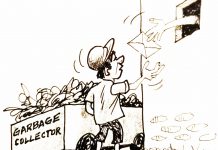Just recently, a news organization published an “exclusive” of a photograph well over three decades old, of an alleged war criminal long thought to be dead. The face was distinct, the eyes were bright, and his countenance—now expressive and emotional on tape—seemed to have just been taken. Except it wasn’t there. AI erased the scratches, brought the face to life, and infused it with human emotion on a dead visage. Just like that, history was manipulated, and the public was misled. The tools are powerful, yes—but we’ve built a monster that’s devouring truth.
I can’t help but feel that we’ve wandered into a dangerous jungle, where even the light that filters through the trees can no longer be trusted. It’s not that we don’t know what’s real anymore—it’s that reality itself is now an illusion game, ready to be edited and revised. A lost photograph has carried a tale in silence, a whispered clue of the past. Now the same photograph can smile, wink, cry, or offer dialogue in perfect meter, all thanks to an algorithm. What was sacred once—the authenticity of a grasped moment—is now the raw material that digital puppeteers play with.
Deception used to require getting dressed up and going into a room to deceive. Now lies can be constructed out of pixels and vomited onto the world in two seconds. One manipulated video is all it takes to ruin a career, justify a war, or get a country worked into a lather. The avalanche of trust is no longer incremental; it’s a snowball effect. The occasional prank has now become an everyday show, complete with filters, captions, and manufactured charisma. The line between fiction and reality has grown so blurry that even the brightest of eyes are beginning to blink.
I know people who brush this off as mere innocence, cyber sorcery that brings back old memories, or entertains with artificially created nostalgia. Nostalgia falls short when crafted by cold calculation. When a machine causes your deceased grandmother to blink and smile in a film you never directed, is it really her, or is it a comforting lie—one you consent to believe because it makes you feel good? We’re no longer being manipulated; we’re manipulating ourselves. The lying is not only ubiquitous—it’s irresistible.
Worst of all, these technologies are not just limited to the artistic or emotional plane. They’re now instruments of politics, used to plant doubt, confusion, and division. Deepfake videos of politicians spouting lies go viral before their denials do. Edited words in courtrooms, impersonated voices in phone scams, cloned faces in pornography—all courtesy of AI—are crimes disguised as smooth tricks. And while we talk about the ethics aspect, the damage just keeps piling up. We are in slow motion, but tech is moving fast. And lies, when they go viral in the wild, do not wait for laws to catch up.
Even journalists, whose job is to pursue the truth, are left grasping for breath in this melee. The question is no longer what is occurring but whether it occurred at all. Sourcing has become a matter of forensic-grade detail. Anything that escapes must be questioned like a suspect. And in the exhausting quest for evidence, many just abandon the effort and convince themselves to believe what they desire—facts be damned. AI hasn’t merely added noise; it’s made fact a luxury.
And yet, the irony is rich: the same wit that builds illusions can also see them. AI can detect contradictions, feel fake patterns, and watermark reality in micro-fashion. But this armor is still but a whisper to the din of deception. We require more than machines; we require a culture that cherishes reality rather than spectacle. Else, we’ll be living in a world where vision is no longer truth, and truth is whatever is convenient to believe now. A world where truth, as we understood it, becomes the final casualty of our so-called sophistication.
All that we can do, at least for now, is to cultivate a suspicious habit without being paranoid. To learn ourselves, and more importantly, the younger generation, about the dangers of false truths. To call tech creators to account, the media, and ourselves. Truth may be on the ropes, but it’s not quite dead yet. It’s alive in critical questioning, in ethical reporting, and in the human desire to know, not what appears to be real, but what is real. We have to make that choice each day to preserve that.




